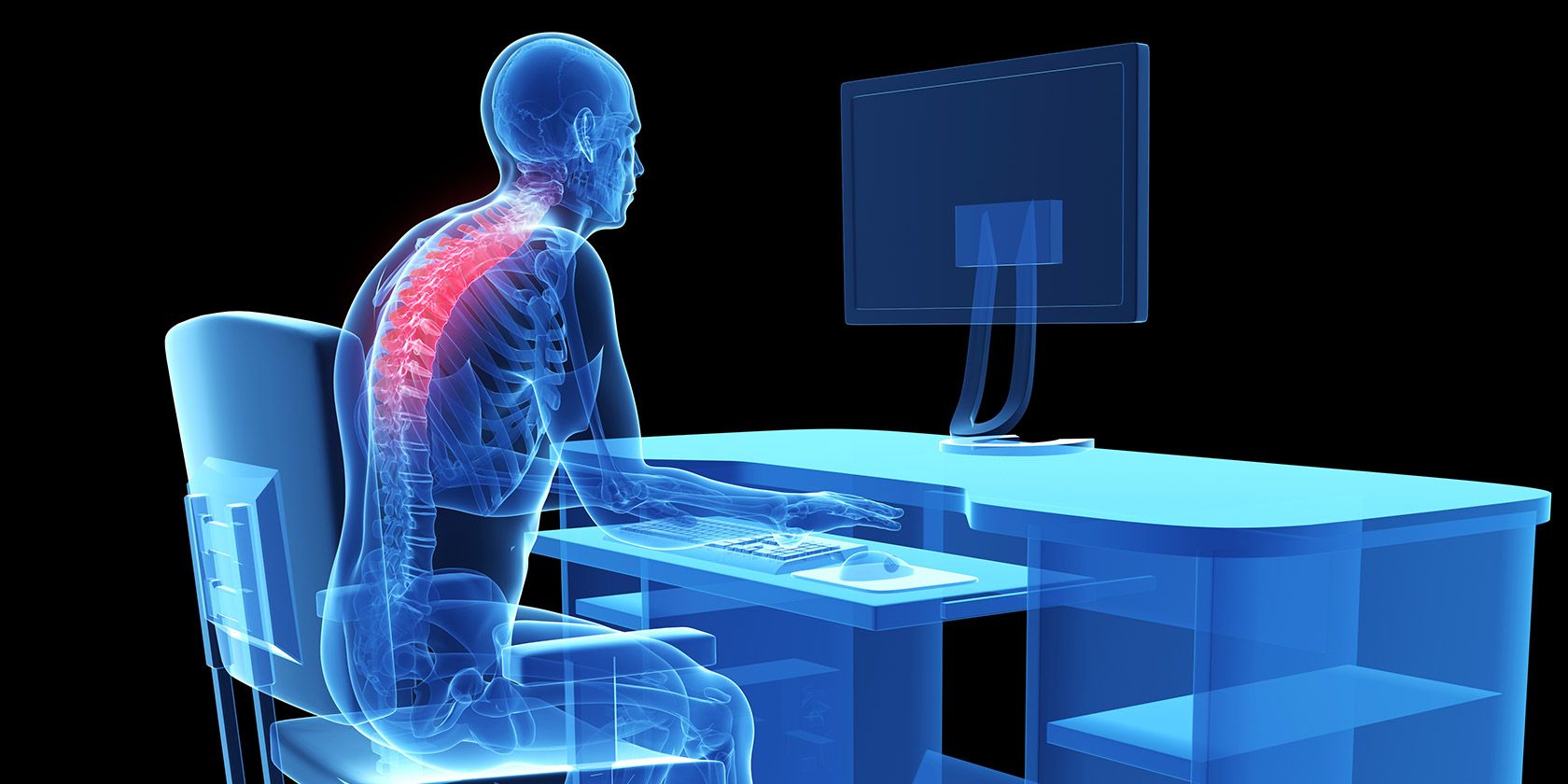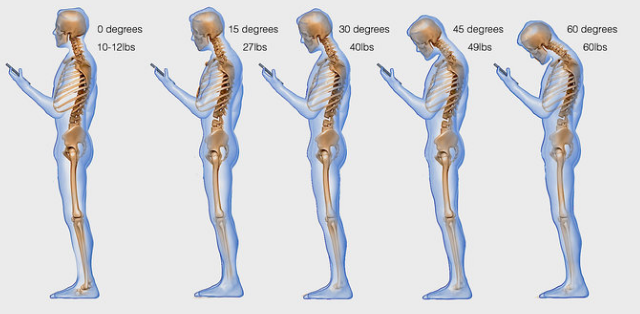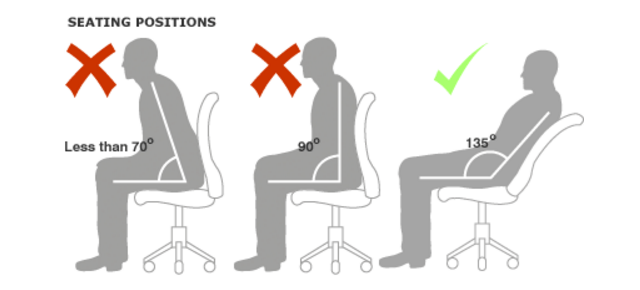According to physical therapist Kelly Starrett, the amount of time we spend sitting is akin to sentencing ourselves to "death by chair".
That stiff neck, sore back, and deteriorating posture are all symptoms of forcing our body to stay in unnatural, sedentary positions for prolonged periods of time. The deadly combo of technology and bad posture habits have given rise to terms like "Computer Back" and "Text Neck".
Rather than allowing these symptoms to worsen and ruin your life, try some of the stretches below. Spending just five minutes per day (though preferably more) following some of these videos will help to soften some of that tense tissue, and relax those stiff muscles.
Disclaimer: I am not a doctor, nor do I play one. If any of these stretches are uncomfortable, don't do them. Consult a trained practitioner for further advice. Especially if any prior discomfort is caused by trauma or congenital issues.
A Sedentary Life is Wrecking Your Body
Being a MakeUseOf reader, I'll assume you spend a good deal of time sitting at a desk, looking at your phone, or playing computer games.
In fact, author Brigid Schulte said in the Washington Post:
"The average office worker sits for about 10 hours, first all those hours in front of the computer, [at work] — and eating lunch. And then all those hours of sitting in front of the TV or surfing the Web at home."
Despite practicing for 10 hours per day, most of us are still clueless about how to properly and safely sit on our hinds.
This leads to sitting at computers damaging our bodies. We end up with joint dysfunction, painful myofascial trigger points, muscle spasms, headaches, and more. Some even succumb to injuries while playing computer games, such as tendonitis. In fact, many people who've adopted standing desks are still damaging their posture.
Before continuing then, be sure to read this short article on how to properly sit at your desk. Good sitting technique should put the brakes on your posture and discomfort from getting any worse. But when it comes to reversing damage already done, try some of the following stretches.
Fixing "Computer Back"
Also known as posterior cervical dorsal syndrome, "Computer Back" is caused by an "excessive rearward curving of your lower, middle, and upper back". Its physical manifestations are a curving of your upper neck, upper back (thoracic spine), rounded shoulders, and a head that's a little too far forward.
As you continue to sit in this hunched position, the postural muscles in your upper back become weaker. On top of this, the increased muscle tension (and pain) can pass to other parts of your body. For instance, from your neck and back to your chest and shoulders.
If you're short on time, try just one of the stretches below for now. But for best results, do them together as a short stretch sequence (around 7 minutes).
Upper Back Rotation
Lay on your left side with your knees and hands touching. Keeping your left hand on the floor, and your knees together, draw an arch with your right hand up and over your body, moving only your arm and upper/mid back. Bring your arm back. Do this 5–10 times on the left side. Repeat the stretch on the right side.
4-Minute Back Sequence
Get onto all fours. As you exhale arch your back, pushing your upper back toward the sky. Hold for 5-6 seconds. As you inhale arch your back the other way, push your chest toward the floor, and hold. Do this six times.
Now, keeping your hands on the floor rock back so your butt is on your heels. Push your hips backward, and your arms forward as far as you can. Feel your spine being stretched out. Hold for 20-30 seconds.
From this position, slide forward, and push your pelvis into the ground, holding your upper body with your arms as straight as you can. Your back will be bent backward, with your legs pushing hard into the floor. Hold for 20–30 seconds.
Finally, grab a pillow. Keeping your legs bent, lie on the floor, with the pillow underneath your mid/upper back. Place your arms on the floor above your head, and hold the position for a couple of minutes.
Door Stretch
Rounded shoulders are a tell-tale sign that either someone's been lifting too much at the gym, or they've been sat at a computer for too long.
As the muscles in the chest tighten, the shoulders are pulled forward. To counter this, you need to stretch open the chest muscles, while strengthening the muscles that pull your shoulders back toward the spine (rhomboids). The easiest exercise I've found for this is the door stretch (above). If you have the time though, go through all the stretches in this video.
Place one forearm on each side of a door frame, with your elbows at 90-degrees. Lean forwards so you can feel your chest stretching, and your shoulder blades compressing. Hold for 10–15 seconds. Lift your arms slightly higher, and repeat. Lower your arms slightly, and repeat again. Do the stretch another 2 or 3 times.
Fixing "Text Neck"
Also a symptom of Computer Back, "Text Neck" is where your neck forces your head to protrude more than it naturally should, pushing it out of alignment with your spine.
This is relatively common for people who sit at a computer all day. But it's made even worse by excessive use of smartphones. Research from Dr. Kenneth Hansraj shows that the angle at which most of us look at our phones places an additional 60-lbs of stress on our neck muscles. No wonder your neck is causing you so much pain.
Stretching out your chest, and pulling back your rounded shoulders can help with text neck, but the stretch below isolates the specific muscles causing the problem.
Chin Tuck
There are a few variations of the chin tuck. The simplest is when you place your index finger on your chin, then pull your chin back (not down). Hold for 5–10 seconds, then place your chin back on your index finger. Repeat 5–6 times. Personally though, I prefer the stretch below.
Stand with your back against a wall, with your shoulders relaxed and your mouth closed. Push your head back to place your crown on the wall. Now gently tuck your chin toward the wall. You should feel your crown slightly slide up the wall. Hold for a few slow breaths, and repeat 3–6 times. Repeat this stretch a few times throughout the day.
If you would like even more exercises to help with text neck, follow this 15-minute yoga workout that you can perform at your desk.
Fixing Short Hip Flexors
Being hunched over a desk for hours on end doesn't just affect your upper body. It also causes problems with the muscles around your hips and elsewhere. If you sit for long periods without working these muscles, you're probably suffering from shortened hip flexors.
Hip flexors are the muscles that connect to your hip and are used to propel the knee forward and upward. If they're not pulling their weight, this can cause problems with the muscles in your butt (glutes), lower back, and hamstrings.
Try the following stretches to stretch out your hip flexors, and to help your glutes and hamstrings overcome the extra work they're needing to put in.
Hip Flexor Stretch
Place your left knee on the floor, and your right foot flat on the floor, facing forward. Straighten your back. Tighten your glutes (you butt muscles), and slightly tighten your abs (stomach). You should feel your pelvis push forward. At the same time, you should feel a stretch in the muscle running from your hip, down the front of your thigh (your hip flexor).
It's important to keep your abs and (especially) your glutes relatively tight. This will work to reduce lower back pain. Gently lunge slightly forward to intensify the stretch. Don't make this too uncomfortable. Hold the position for 10–20 seconds, and repeat three times. Shift legs, and repeat. Continue watching the above video for some variations of this stretch.
If your hips feel especially tight, you'll want to work on other stretches that work the hips in different directions.
An Improved Posture
By leading a sedentary life, and spending a lot of time sitting, several muscle groups become tight and weak. This leads to all sorts of postural distortions like those above. Many of these distortions can lead to excruciating pain.
As mentioned, the first step here is to make sure that when you're sitting, you're sitting properly. If your job requires you to sit for long periods, make sure you stand up and walk around every 20–30 minutes.
The Benefits Are Life Changing
Bookmark this article. Come back to these stretches regularly. Be careful not to push yourself too far.
The aim is to gradually tease your muscles back into their healthy, natural positions (after all, "posture" originates from the Latin word for "position"). If you have the time, go to the start of each the videos above, and go through all of the stretches within them. Your body will thank you for it.
Try these stretches at least two or three times per week, and after two weeks, let us know how you're feeling in the comments below!
Image Credit: wrong sitting posture by Sebastian Kaulitzki via Shutterstock, Office Woman Back Pain by Lisa S. via Shutterstock




